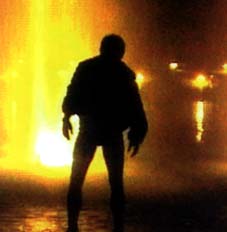 |
Vol 0, No 33
10 May 1999 |
|
|
City of the Lonely Fred Kelemen's Verhaengnis Andrew J Horton One of the most remarkable debut films of this decade has been Fred Kelemen's Verhaengnis (Fate, 1994). Shot on Hi-8 video and transferred to 16mm film in a manner designed to keep quality to a minimum, this lo-fi lyric poem about bleakness and mortality has attracted high praise from the likes of essayist and social commentator Susan Sontag. Taking place over one night in Berlin, Verhaengnis follows first a Russian accordion player and then his girlfriend through a city made strange and hostile, a Berlin which has become the haunt of wandering, lost people from all over the world. With unusual visual poetry, Verhaengnis builds up its "story" through a series of long, slow takes with little dialogue or action. Although the scenes flow into each other smoothly and there is a uniformity of mood and message, the film is basically constructed of a series of independent situations linked chronologically in time and encompassing such motifs as tangos, vodka drinking, pool, infidelity, death, despair and rape. Verhaengnis compresses Europe, and indeed the world, into small localised spaces. Cultures, attitudes and experiences are condensed down into a few seedy Berlin back streets and a couple of shabby apartments. For all this starkness, however, Verhaengnis is a strangely beautiful film and the loneliness of the characters takes on an eerie form of inner strength against the harshness of the outer world. Those who have little stomach for such loose story lines will be relieved to know that Verhaengnis is a mere eighty minutes long. This contrasts sharply with the director's second film, Frost (1998), which has a running time of three hours. Few people have seen Frost, however, since the film was withdrawn following an argument between Kelemen and his producer (see postscript). Those who where lucky enough to catch it gave rhapsodic reports before the film vanished from circulation. Indeed, the recent UK season that Verhaengnis has been enjoying is as much a hommage to Frost as it is a sign of its own success. Both films have won Kelemen numerous accolades and flattering comparisons to films such as Aleksandr Sokurov's Mat i syn (Mother and Son, 1998) and Bela Tarr's seven-hour epic Satantango (Satan's Tango, 1994), both of which post-date Kelemen's debut. Given the success of Verhaengnis - even the most philistine of reviewers in the low-brow UK press had to confess it was worth watching - prying eyes will surely focus on Kelemen, curious to see if the debate that removed Frost from circulation can be resolved and, if in the regrettable case that it can not, what Kelemen's next project will be. Andrew J Horton, 10 May 1999 (republished 22 November 1999) Postscript Since the writing of this article, the dispute between Kelemen and his producer has been resolved and the German TV channel ZDF now own the rights to the film and have made one subtitled print of the film available. Further Surfing Click here for a review of Kelemen's Abendland (Nightfall, 1999).
|
|
![]()
Copyright (c) 1999 - Central Europe Review and Internet servis, a.s.
All Rights
Reserved
